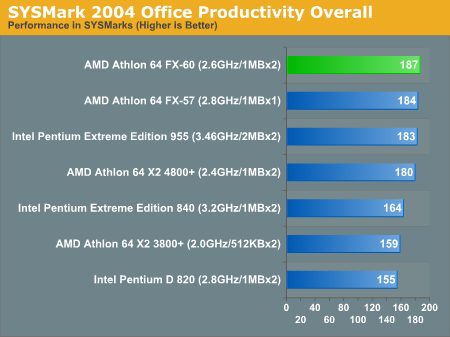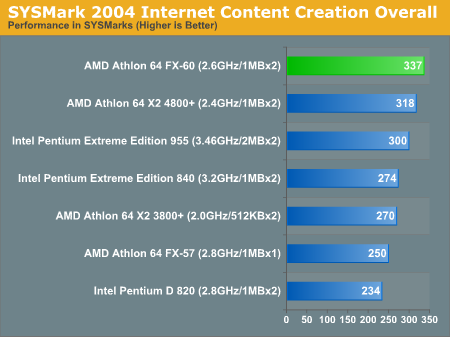AMD Athlon 64 FX-60: A Dual-Core farewell to Socket-939
by Anand Lal Shimpi on January 9, 2006 11:59 PM EST- Posted in
- CPUs
Overall Performance using SYSMark 2004
Office Productivity SYSMark 2004
SYSMark's Office Productivity suite consists of three tests, the first of which is the Communication test. The Communication test consists of the following:
ICC SYSMark 2004
The first category that we will deal with is 3D Content Creation. The tests that make up this benchmark are described below:
Office Productivity SYSMark 2004
SYSMark's Office Productivity suite consists of three tests, the first of which is the Communication test. The Communication test consists of the following:
"The user receives an email in Outlook 2002 that contains a collection of documents in a zip file. The user reviews his email and updates his calendar while VirusScan 7.0 scans the system. The corporate web site is viewed in Internet Explorer 6.0. Finally, Internet Explorer is used to look at samples of the web pages and documents created during the scenario."The next test is Document Creation performance:
"The user edits the document using Word 2002. He transcribes an audio file into a document using Dragon NaturallySpeaking 6. Once the document has all the necessary pieces in place, the user changes it into a portable format for easy and secure distribution using Acrobat 5.0.5. The user creates a marketing presentation in PowerPoint 2002 and adds elements to a slide show template."The final test in our Office Productivity suite is Data Analysis, which BAPCo describes as:
"The user opens a database using Access 2002 and runs some queries. A collection of documents are archived using WinZip 8.1. The queries' results are imported into a spreadsheet using Excel 2002 and are used to generate graphical charts."

ICC SYSMark 2004
The first category that we will deal with is 3D Content Creation. The tests that make up this benchmark are described below:
"The user renders a 3D model to a bitmap using 3ds max 5.1, while preparing web pages in Dreamweaver MX. Then the user renders a 3D animation in a vector graphics format."Next, we have 2D Content Creation performance:
"The user uses Premiere 6.5 to create a movie from several raw input movie cuts and sound cuts and starts exporting it. While waiting on this operation, the user imports the rendered image into Photoshop 7.01, modifies it and saves the results. Once the movie is assembled, the user edits it and creates special effects using After Effects 5.5."The Internet Content Creation suite is rounded up with a Web Publishing performance test:
"The user extracts content from an archive using WinZip 8.1. Meanwhile, he uses Flash MX to open the exported 3D vector graphics file. He modifies it by including other pictures and optimizes it for faster animation. The final movie with the special effects is then compressed using Windows Media Encoder 9 series in a format that can be broadcast over broadband Internet. The web site is given the final touches in Dreamweaver MX and the system is scanned by VirusScan 7.0."












94 Comments
View All Comments
shortylickens - Tuesday, January 10, 2006 - link
Is it just me or does AMD seem to be moving architectures along a little too quickly?Socket A had an incredibly long lifespan. It moved from Athlon B's to C's (thunderbird) to XP to MP and even a Duron thrown in for good measure.
With the tow of the latest passing on (754,940) it seems like AMD just cant get it right. Now they are are already peaking with socket 939. From now on, we'll only have pity chips thrown to us just so we dont feel bad about going into it.
Well I feel bad. :(
Nyati13 - Tuesday, January 10, 2006 - link
Socket A was around for a long time, but there were 4 different FSB specs, several different chipsets, and 2 different RAM types all lumped under Socket A. You couldn't tell for certain that a Socket A CPU would work with any random Socket A motherboard because of all the spec changes. You can say that any Socket 939 CPU will work in any Socket 939 motherboard.DigitalDivine - Tuesday, January 10, 2006 - link
That's the disadvantage of having an integrated memory controller. Memory types change, and in the past there have been numerous memory types, in order to take advantage of the changes, amd has to change their socket.jakerugged - Tuesday, January 10, 2006 - link
In the review under the gaming tests you say - "We should also mention that we had to re-run our AMD numbers in this test since the last review as we were seeing sub-par AMD performance. A clean install and re-run of the numbers yielded the results you see today; the Intel numbers didn't change." Why did the Intel numbers NOT change and why did the AMD numbers change? Was it only in the Gaming tests or once you had good AMD numbers in the gaming tests did you then run the SYSMARK, etc tests in order to get max performance? If you did thats not good testing methodolgy. Can we see these sub-par numbers, how bad are they?Its ok to say that this CPU is fast but only if you add in that you may have to repeatedly re-load and re set-up your system until it is "just so" before it gives the kind of performance that you would expect.
Betwon - Tuesday, January 10, 2006 - link
About the of FX-60, they(both the websites) find:"our processor worked just fine at 2.8GHz clock speed. Unfortunately, Athlon 64 FX-60 didn’t get along with the 15x clock multiplier."--from xbitlabs
"With a retail AMD heatsink/fan, the best we could do is 2.8GHz at 1.40V. With more exotic cooling you could probably manage better, but stepping up the voltage all the way up to 1.50V wouldn't yield a 3GHz overclock on air."--from anand
They agree.
jakerugged - Wednesday, January 11, 2006 - link
Whoa there.....This has gone on a little bit longer than even I thought.My original comment was about the general stability of the FX60, because Anandtech.com just put in a little one liner about how they had to re-load the entire FX60 test rig (Im assuming this means re-install the O/S, all drivers, patches and benchmark tools.) because it was not performing correctly. They still have not said why or what these low figures were?
To be honest, Im not really into O/Cing but I am into stability and I dont want to have to re-load my system just so I can play a few games after using Word or sending a couple of e-mails.
Betwon - Tuesday, January 10, 2006 - link
About the of FX-60, they(both the websites) find:"our processor worked just fine at 2.8GHz clock speed. Unfortunately, Athlon 64 FX-60 didn’t get along with the 15x clock multiplier."--from xbitlabs
"With a retail AMD heatsink/fan, the best we could do is 2.8GHz at 1.40V. With more exotic cooling you could probably manage better, but stepping up the voltage all the way up to 1.50V wouldn't yield a 3GHz overclock on air."--from anand
They agree.
PrinceGaz - Tuesday, January 10, 2006 - link
Why don't you quote a bit more of what xbit labs said, Betwon?"We managed to get our CPU to work stably with the clock frequency multiplier set to 14x without increasing the Vcore, which equaled 1.3V throughout the entire test. In other words, our processor worked just fine at 2.8GHz clock speed. Unfortunately, Athlon 64 FX-60 didn’t get along with the 15x clock multiplier.
Having increased the Vcore by 10% above the nominal, we still couldn’t get our hero to run stably at 3GHz frequency. Although the CPU would boot the Windows XP just fine and could even go through some test applications, it would still crash to the Blue Screen of Death (BSOD) when both cores were fully loaded. So, we had to give up or desperate intention to conquer the 3GHz height.
We managed to get our processor to work absolutely impeccably at 2.9GHz with the Vcore set to 1.44V. This frequency was achieved as 14 x 207MHz."
So they managed 2.9GHz totally stable, not just 2.8GHz. And on the final page
"However, we shouldn’t say that Presler got completely and hopelessly defeated by the new Athlon 64 FX-60. Due to the new finer production technology, the new dual-core processors from Intel can boast excellent overclocking potential. As for the frequency potential of the AMD processors, it has been almost completely exhausted by now. As a result, when we compare the results demonstrated by the overclocked AMD Athlon 64 FX-60 and Intel Pentium Extreme Edition 955, the former is not always the winner. So, if you do not mind your system being a little bit noisy and generating quite a bit of heat, then Pentium Extreme Edition 955 might be a way to go."
Note the wording-- "the former [o/c FX-60] is not always the winner". The meaning being that the FX-60 at 2.9GHz beats the EE955 at 4.26GHz more often than not, but there are situations where the o/c EE955 wins. So when both are overclocked to their max, they are either equal or the FX-60 has a slight advantage overall. Of course the FX-60 has a significant advantage when it comes to heat, power consumption, and noise.
Betwon - Tuesday, January 10, 2006 - link
I had say that:"OC:
955 is 4.26GHz, FX-60 is 2.9GHz -->Now, the ratio is 1.46 (4.26/2.9). -->P4 starts to be better than X2. "
Note:
"As for the frequency potential of the AMD processors, it has been almost completely exhausted by now."
"Due to the new finer production technology, the new dual-core processors from Intel can boast excellent overclocking potential."
flyck - Tuesday, January 10, 2006 - link
but they also benchmark them both... and p4 is overclocked in those benchmarks still slower then X2. And they also say the power consumption of that overclocked p4 is insane.